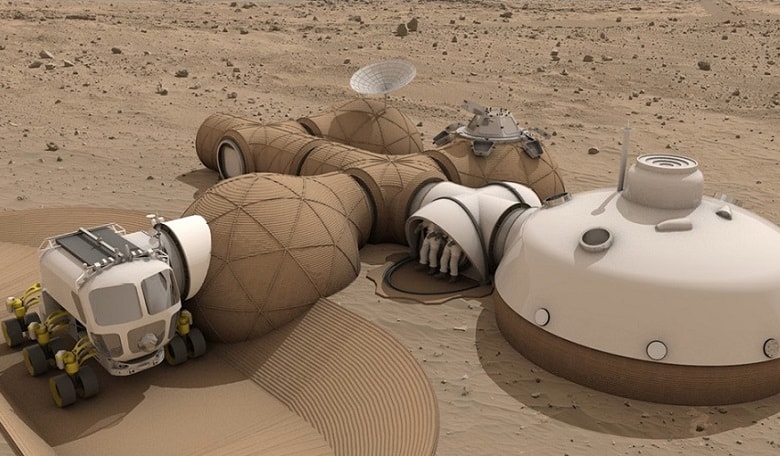Inspired by centuries-old construction techniques, LavaHive is a Mars colony built using the planet’s own sand and dust. Such in-situ resource utilization makes it possible to make significant savings on the mass and cost of a mission to the Red Planet. Both NASA and ESA have demonstrated an interest in this technique as a way of achieving their ambition.
Additive manufacturing has captured both commercial and public interest in recent years. Often referred to as 3D printing, a slew of disruptive commercial applications have already been demonstrated and many more foreseen. Now, teams around the world have been inspired to design a 3D-printed Mars habitat for a NASA competition.
As a process, 3D printing of sorts has existed since antiquity, when grand structures were built additively, layer by layer. It is only recently that we have combined the technique with robotics and computer control, enabling 3D printing of objects of nearly any shape using a diverse range of materials, from metals to plastics and even ceramics. Certain complex geometries, impossible to make using traditional manufacturing techniques, are also made possible using 3D printing methodologies.
The advantages are numerous – logistical requirements, materials usage and manufacturing time are all reduced. And product applications are wide in range, from low-weight bespoke jet engine parts to the fabrication of complete concrete houses.
The mission-enabling potential of this technology is not lost on the space agencies. In 2013, ESA commissioned a study under its General Studies Programme to investigate how 3D print methodologies could be used to fabricate a dome-like structure for a lunar facility, protecting astronauts from the harsh radiation and micrometeorite impacts on the Moon. By using local resources to fabricate important mission elements as opposed to shipping them from Earth, an application known as in-situ resource utilization (ISRU), it’s possible to make significant savings on the mass and cost of the mission.
 The sub-habitats are working areas, with walls that are 3D-printed from Martian sand and dust
The sub-habitats are working areas, with walls that are 3D-printed from Martian sand and dust
NASA has also turned its attention to the possibilities of using 3D printing on space missions. In March 2015, it announced the 3D Printed Habitat Challenge, which is open to entrants from across the globe. Teams put forward an architectural concept for a 3D-printed Mars base, with the aim of fostering the development of technologies necessary to additively manufacture a habitat using ISRU and the recycling of spacecraft materials. It’s a so-called NASA Centennial Challenge - an incentive prize offered to generate disruptive solutions to problems of interest to NASA. With this approach, NASA aims to engage with non-traditional sources including the global ‘maker’ community – enthusiasts and entrepreneurs from the general public who have championed 3D printing technology and its applications.
Inspired by the previous study carried out by ESA on lunar 3D printing, a team consisting of members of the European Astronaut Centre and Liquifer Systems Group of Austria have joined forces to develop a concept for this Centennial Challenge. The team has been selected as one of the top 30 entries out of more than 160 entrants, and asked to present its concept at the World Maker Faire in New York in September 2015.
Architectural inspiration
The concept, named LavaHive, shows the unique potential that additive manufacturing technologies have for future exploration missions. In the proposal, the feedstock material used as raw material for the 3D printing process is Martian ‘regolith’, a catch-all term for the loose sand and dust that’s readily available on the surface of Mars. By using this local material to produce structures and shelters, significant mass savings can be realized, leading to a reduced logistical supply burden from Earth.
The LavaHive concept is a novel hybrid approach. It consists of an inflatable central habitat with 3D-printed reinforcement walls, and a series of interconnected sub-habitats made from sintered and molten Martian regolith, plus recycled and repurposed spacecraft parts. Sintering involves using heat and/or pressure to fuse particles, and its feasibility using regolith has been demonstrated on Earth via numerous projects.
Architectural inspiration came from Irish Clochan beehive huts and traditional South Italian Trulli homes.
LavaHive is a modular design for an initial mission of four crew, with the ability to expand or adapt to changing mission requirements. In its initial state, a hybrid inflatable-3D printed main habitat is connected via a central corridor to three or more sub-habitats. The main habitat houses crew living areas and is connected via 3D-printed passageways with the sub-habitats. These house a laboratory, greenhouse, garage airlock and other required working areas. There are a number of reasons to adopt a hybrid approach of purely 3D-printed sub-habitats connected to a central inflatable habitat brought from Earth. The central inflatable habitat offers a number of advantages, such as assured structural integrity as well as the ability to house essential functionality such as the Environmental Control and Life Support System (ECLSS) modules and environmental sealing of the habitat.
The back-shell from the Entry, Descent and Landing (EDL) system will be recycled as the roof of this central habitat. This will be used to reinforce and protect the inflatable structure that deploys underneath from hazards such as micrometeorites and radiation.
The architectural inspiration came from two examples of ancient ‘habitats’ - the Clochan beehive huts of the Irish monastic sites and the traditional South Italian Trulli homes. These are domed houses with prehistoric origins, built using the abundant stone materials from the surrounding land - a true example of ancient ISRU on Earth. In the Trulli, a plaster made of reddish clay soil and pieces of straw mixed with slaked lime was used to render the interiors of these houses hygienic and clean, similar to LavaHive’s proposed method of sealing. For the ancients, the final result was an earthquake-proof construction that, thanks to the thermal inertia of the thick walls, provided a cool environment in hot weather and kept warm in winter.
Building the habitat
On arrival in the Martian vicinity, the mission delivery vehicle will detach the EDL system and send it on a trajectory towards the surface. The EDL will jettison its heat shield and then deliver two surface rovers and the central inflatable section of the habitat to Mars.
The two autonomous rovers included in this payload will be used for the 3D construction process, with one used to sinter and the other used to melt regolith. When the entry capsule comes to rest on site, the inflatable habitat will deploy with the EDL back-shell still attached on top. This will offer additional protection to this critical central node of the habitat.
A key element of LavaHive is to make use of components that are usually discarded
The two autonomous rovers will then begin preparing of the area for the construction of the 3D-printed elements. The rovers will identify and collect the local fine regolith sources available from aeolian, or wind-created, deposits within craters and beds and transport them to the habitat site. First, the sintering-capable rover of the pair will begin producing foundations for the smaller habitat sections, with the foundation then completed by the lava-forming robot.
The rovers will then work in tandem to begin the fabrication of the habitat sections and connecting corridors using in-situ regolith resources. When one cast layer has cooled, the rover begins layering more regolith sand, and a new channel is sintered on top. This process is repeated until the dome is complete. Once arrived, astronauts will perform final construction operations tele-robotically from Mars orbit or manually from the surface. They’ll install mission elements brought from orbit, such as airlocks and safety doors. Once structurally complete, the sub-habitats will be hermetically sealed with epoxy coating on the inside surfaces of the sub-habitats, sprayed on by a rover. This epoxy will form a sealed environment with the main habitat.
 LavaHive is a modular structure for Mars, with central crew quarters connected to 3D-printed sub-habitats. With thanks to LIQUIFER Systems Group who conceptualized the overall layout, derived an architectural concept and rendered visualizations for this project.
LavaHive is a modular structure for Mars, with central crew quarters connected to 3D-printed sub-habitats. With thanks to LIQUIFER Systems Group who conceptualized the overall layout, derived an architectural concept and rendered visualizations for this project.
A key element of the LavaHive habitat concept is to make use of components that are usually discarded, such as the EDL back-shell to protect the inflatable habitat section. In addition, materials like nylon, polyester, Kevlar, low density polyethylene, titanium, carbon fibre composites, polyimide and PTFE, and parts such as fuel tanks and wiring will be taken from the EDL system post-landing. They’ll be reused inside the habitat: for example as storage for water or gas. The recycling of polymers opens up novel reuse applications within the interior of the habitat. Using the waste polymers as feedstock for existing plastic additive manufacturing techniques, it is possible to produce a variety of mission-specific tools and fittings. This recycling approach increases mission flexibility, allowing ad-hoc production of parts as the need arises and is paramount for a logistically self-sustaining mission to Mars.
Why we love lava
Printing using lava may seem incredible, but is in fact an elegant and simple approach. The lava-casting manufacturing process is inspired by naturally occurring lava flows and its feasibility has been confirmed by small-scale demonstration projects here on Earth.
The aeolian dunes and beds from which regolith could be collected are well understood in terms of their particle size distributions, which is an important consideration for understanding the dynamics of any sintering process. The regolith will be melted inside a furnace on the rover, and then cast in channels made from sintered regolith.
This lava 3D printing approach has several advantages. First, as a building material, it is stronger than thermally induced sintered material. Since the four-man astronaut team would be expected to work safely within these 3D-printed structures, confidence in the structural elements supporting the rooms is crucial. Second, we can expect basaltic lava, once cooled, to have a much higher density than any sintered material. This would have considerable benefits for radiation shielding in the surface environment. The permeability of basalt stone is also superior to that of a sintered process, which is often porous, and this is an important consideration for forming a hermetic environmental seal.
While it may seem difficult, heating and control of the lava itself is relatively easy to achieve. Lava is highly viscous yet can readily flow long distances before cooling. An analogue test habitat on Earth is also easily achievable, and lessons learned during construction of terrestrial Mars analogue sites would be transferable to the Martian environment.
 ESA’s idea of a 3D-printed lunar base has a dome designed by architects Foster + Partners
ESA’s idea of a 3D-printed lunar base has a dome designed by architects Foster + Partners
As a concept, the LavaHive approach is a great example of how ISRU and 3D printing can be combined to enable exploration missions on the Martian surface. Many of the concepts, like the sintering of regolith, are already being proposed for lunar exploration. The techniques would need to be further developed and tested here on Earth, but this is also a latter part of the NASA Centennial Challenge.
The additive manufacturing movement has shown that changing the way you approach fabrication can open up new possibilities. That future explorers would end up employing the construction processes used by our ancient forebears for the first Martian habitat is fitting for the development of our own first settlements off Earth.














